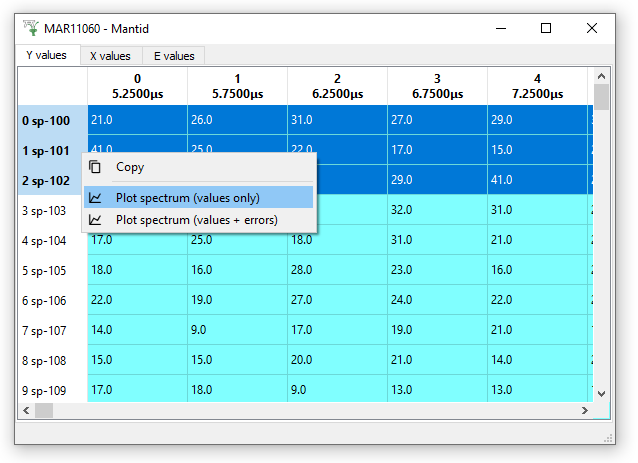\(\renewcommand\AA{\unicode{x212B}}\)
Displaying 1D Data
The Simplest Plot
- Load “MAR11060”.
- Right click the workspace in the workspace list.
- Select “Plot > Spectrum …”.
- In the dialog that appears enter “1-3” in the spectra number box.
- Click “OK”.
You should get a plot like this with three spectra corresponding to
spectra 1-3 (which in this case these are the monitors on MARI):
Another way to plot
- Load MAR11060.raw, but this time set SpectrumMin to be “100” and
SpectrumMax to be “200”. Because the values are inclusive, we are
actually loading 101 spectra, starting at 100.
- Display the matrix window to view the data.
- Select multiple rows using one of the following methods:
- Click the first index label, and then hold shift while selecting
the last.
- Click and drag down the index labels to select as many as you
want.
- Click while holding Ctrl to select / deselect individual rows.
- Please highlight rows 0-2 and bring up the following right-click
menu. Select
Plot spectrum (values only).
- You will be presented with options for plotting the selected spectra,
with and without errors. Select “Plot Spectra” (showing the values
only):
Notice the legend entries “MAR11060: spec 100”, …, “MAR11060: spec 102”,
where “spec” is shorthand for Spectrum Number.
Adding a curve to an existing plot
There are two ways to add spectra to an already existing graph, either
from the same workspace or from another.
- Drag the Workspace from the Workspace List and drop it onto the
graph you want to add the curve to.
- Right-click the Workspace from the Workspace list and Select “Plot > Overplot spectrum …”. This will attach your additional spectra to your last active plot.
- In both cases, if the Workspace contains more than one spectra you will
be asked which spectra you wish to add to the plot.
